Factual error: The lake that Jack told Rose he went ice fishing on when she was threatening to jump is Lake Wissota, a man-made lake in Wisconsin near Chippewa Falls (where Jack grew up). The lake was only filled with water in 1918 when a power company built a dam on the Chippewa River, six years after the Titanic sank. (00:39:05)
Factual error: At the end of the movie, the Straus' are seen lying in each other's arms on their bed with water coming into the cabin under the closed door as the ship is sinking. This is not true, their cabin was on C deck, but his body was found in the following days of the sinking. For his body to get into the open water it would have had to float through a closed door, and up several flights of stairs. Historically, they refused to leave the ship, and were last seen sitting in deck chairs. They were there when the ship sank on the boat deck. Her body was never recovered.
Factual error: Rose mentions Austrian psychoanalyst Sigmund Freud's ideas on the male preoccupation with size to Bruce. However this is 1912, and Freud did not publish the work relating to this until 1920 in "Beyond The Pleasure Principle." Also, up until 1919, Freud relied solely on data from women. (00:33:40)
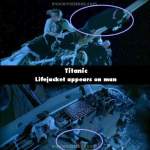
Continuity mistake: When Jack and Rose are going down with the ship, there is a man holding onto the flagpole. The man's life jacket disappears and reappears. (02:42:42)
Factual error: In the film the water tight doors are shown to lower mechanically all the way down, however in reality the last 20 inches or so they would suddenly drop by their own weight to effectively "dent" into the floor creating the water tight seal. A few of the crew in the film getting through "at the last moment" would have actually had their lower legs shattered by several tonnes of iron.
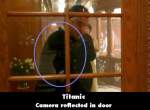
Visible crew/equipment: When Jack comes to the first class door for the first time in his tux, you can see a cameraman in the glass door just before he enters. (00:54:55)
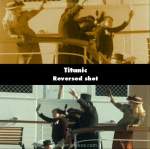
Deliberate mistake: In the scene at the start of the movie with the "authentic" piece of film, you can see a girl with a hat waving to the people at the ground. When the ship is leaving port in the film, she and others are in the same positions, only in reverse, because the first "authentic" shot is the same shot, only mirrored. (00:00:40 - 00:25:30)
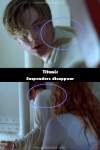
Continuity mistake: When Rose breaks Jack's handcuffs, you can see the stunt person not wearing suspenders as Jack does. This is an inter cut shot between the raising of the axe and the striking of the cuffs. Leonardo's stunt double is noticeable in other shots throughout the film. (02:01:00)
Factual error: The hymn that they sing at the church service about "those in peril on the sea" has four verses. "Peril on the sea" was written in 1860 but the verses that have "protect them by Thy guarding hand" and "O Spirit whom the Father sent" were not written until 1937, and thus could not have been sung at the service. (01:10:40)
Factual error: When the men are checking the store room for Rose and Jack, the men are using huge battery powered bright white flash lights that look like they're from Jurassic Park. Back then they would have produced yellow light. The light used in the movie was a Short-Arc Xenon bulb, you can tell this by both the very high color temperature of the light and the center of the light has a "hole" in it where the actual tube is blocking the beam. Such technology was not around at that time. (01:33:15)
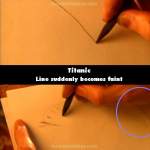
Continuity mistake: Just as Jack begins to draw naked Rose, he draws a dark line down the center of his paper. In the next shot of the page the line is suddenly much fainter (over to the right) and he is now drawing her face. (01:23:15)
Revealing mistake: When Jack and Rose are running from the raging water that is gushing down the hall after them you can see the faces of the stunt doubles through the computer generated ones of Leonardo and Kate (slow motion can help but isn't essential). (02:17:15)
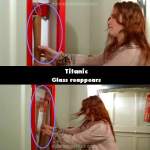
Continuity mistake: When Rose is trying to rescue Jack she spies a fire axe. Smashing all the glass out from the holder she grabs the axe and turns round. The next camera shot shows Rose standing in front of the case with almost all of its glass intact. (01:59:25)

Revealing mistake: When Rose breaks Jack's handcuffs with an axe, it is obvious that she doesn't hit the handcuffs on the pipe but Jack's hand - the handcuffs come apart by themselves. The axe also bends. (02:01:30)
Continuity mistake: When Jack is persuading Rose not to jump, Jack's shirt collar changes position several times, revealing his white t-shirt from a little to a lot. (00:39:05)
Factual error: During the drawing scene, 'Jack' is using modern square sided, pressed charcoal with numbers embossed in the side of it. In 1912, Jack would have been using vine charcoal which was round and made of 'charcoalized' willow twigs. (01:23:30)

Continuity mistake: Look closely at the location of Rose's beauty-mark the first time you see her at the dock. It is on the opposite side of her face during the rest of the movie. (00:21:30)
Factual error: In the beginning of the film, when Jack is running to the boat on the pier, his rucksack is a Swedish Army rucksack, model 1939, and nowadays widely sold as army surplus. (00:25:10)
Factual error: Margaret Brown never went by the name of "Molly" Brown during her lifetime. It was not until after her death that she was referred to as "The unsinkable MOLLY Brown". (00:27:50)

Revealing mistake: When Cal steps out of the car just after the beginning of the movie, you can see behind him the back of the Titanic replica still incomplete, with the internal structure totally visible. (00:22:06)
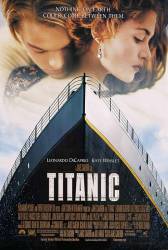





Chosen answer: Because she is considered, in a minor sense, a "villain" in this film for forcing her daughter into a loveless arranged marriage to satisfy her personal wants, most fans probably speculate that she became a poor and penniless seamstress and lived out her life working in a factory. Of course, this is possible, without the financial security of the arranged marriage between Cal and Rose. However, it is difficult to believe that a woman of such status, and who has so many wealthy and powerful friends, would be allowed to languish in abject poverty doing menial labors. I would tend to believe that she probably sold a number of her possessions for money (she did mention that as part of the humiliation she would face if Rose were to refuse Cal's affections), and probably lived off the kindness of others. Given that her daughter was betrothed to a Hockley, his family might have felt an obligation to assist her in finding a suitable living arrangement and a situation for employment. It is also possible that she re-married into wealth. However, this is more unlikely, mainly because back in 1912, it was considered scandalous to re-marry, especially at Ruth's age. However, since Ruth does not make an appearance after surviving the sinking of the Titanic in a lifeboat number 6 (next to Molly Brown), nor is she mentioned again, her fate is left unknown and subject only to speculation.
Michael Albert
In that era, with Rose betrothed to Call, Cal would most definitely have provided for Ruth in the lifestyle she was accustomed to. As Cal angrily raged at Rose the morning after her excursion below decks, "You are my wife in custom if not yet in practice ", thus, society would have viewed him a villain had he not cared for Ruth once it was assumed Rose was dead.